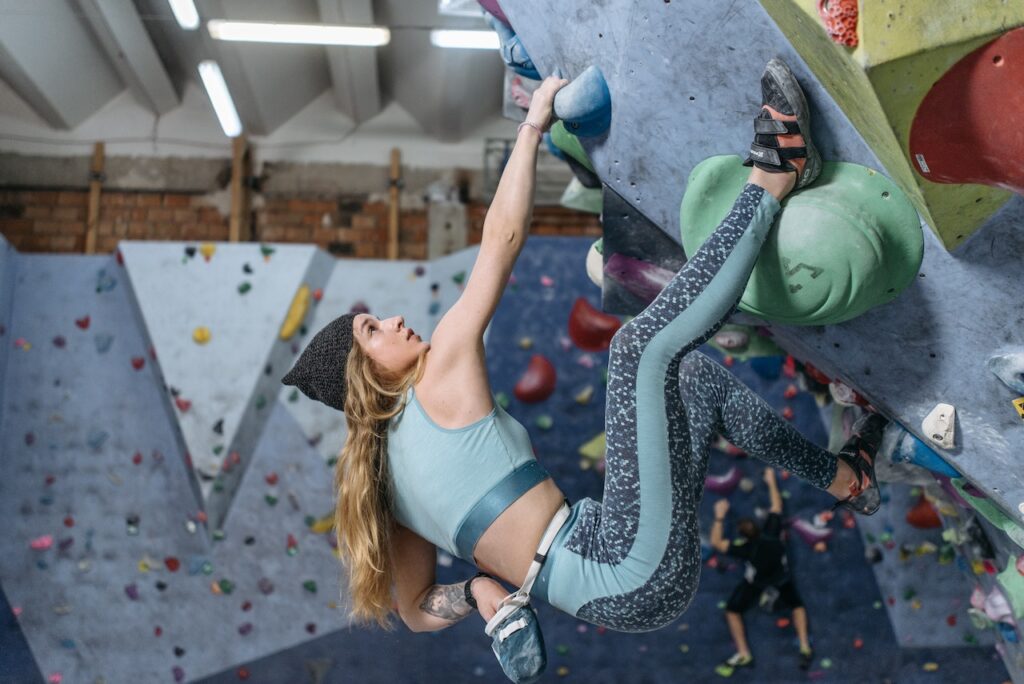It is imperative to know how to climb with straight arms. There are a few super common mistakes in many new climbers’ form, just as there are a few common tips and tricks you’re likely to hear from fellow climbers as you continue to hit the gym. You’ll probably encounter the advice to climb with straight arms. Though it might seem counterintuitive at first, in this article, we’ll talk about what it means to climb using straight arms and why this practice is such an important one for both the health of your body and the success of your climbing.
First, let’s set the scene:
Imagine you’re on a climb and using your arms to pull yourself up to hold after hold. Every time you pull yourself up, your muscles fully engage, and your body offers all its strength. You soar up the first few holds! But, as you near the most complicated move, or the crux, your muscles start to feel tired, your arms and hands begin to twitch as you struggle to pull your legs up after you, then you think your upper body starts to shake.
All that flexing and releasing of your muscles have stopped and started the blood flowing to your arms repeatedly, creating a pulsing tightness in your arms– something your climber friends call getting pumped. You can feel your muscles giving out, but it’s the final move! Your hands swat at the hold, but it’s too late– you’re back on the ground, exhausted and once again met with defeat!
So, this means you’re not strong enough yet, right? You don’t need to focus on gaining more muscle to take down that killer route. You need to use different body parts in some other ways and learn a few techniques for saving energy on the wall.
Why Use Straight Arms?

Instead of relying on our arm muscles to secure our weight, climbers can redistribute the load into their skeletal system by hanging on straightened arms, helping to save their energy for the moves to come. Keeping straight, minimally engaged arms means you’re forced to rely on the strength and steadiness of your legs.
Bending your arms when you climb requires the repeated releasing and re-engaging of your muscles and wastes precious energy every time you make a move. Instead, your arms should remain straight and minimally engaged (read How To section for more on proper technique). Your shoulder sockets will serve as pivot points, allowing you to raise, lower, and swivel your body as needed. Use the movement of your hips to help adjust to the exact position required. Your straightened arms will provide balance and stability as you search for and move your feet to their following holds. Then, place your feet with intent and rely on the strength of those legs! They will hold you up as you move your arms to their following positions. That will be when your arm muscles might engage slightly, but minimizing those bending motions is the goal.
Now, instead of wearing out those less enduring arm muscles and straining your body climb after climb, you’ll be able to move with easier, smoother, more stable motions. You’ll also be using your energy in a much more efficient way, meaning you’re likely to be able to climb harder and longer. As you focus more on your lower body, your center of gravity will be shifted lower along with your hips. The lower your center of gravity, the more stable you become. Focusing less on your hands as primary holds will also force you to be more conscious of your feet placement and technique, another practice that is key to successful climbing.
How To Properly Climb With Straight Arms

Now that you’ve been convinced of the triumphs of straight-arm climbing, you want to make sure you’re relying on that skeletal system in ways that prioritize your body’s health and reduce the risk of injury. Though the point of straight arms is to minimize the amount of energy you’re releasing, your muscles will still be active to an extent. In particular, it’s critical to engage your shoulder muscles and refrain from leaving them loose or locked as you feel your skeletal system take on your body’s weight.
To check if you are correctly engaging these muscles, take note of the closeness of your shoulders to your ears. Your muscles aren’t engaged if your shoulders are pulled up high, as if you’re shrugging or snug against your ears. You want to flex the muscles and pull the shoulders down and back from the ears. You’ll also feel this in your shoulder blades; pull them back as if squeezing a ball between them. Engaging muscles in this way helps protect your shoulders and joints from damage, whereas simply hanging with relaxed muscles will cause damage to muscles, nerves, and tendons. You’re now ready to swivel on those shoulders and hips– you’ll probably notice an increased range of both motion and reach as you swing around, finding the best next position and movement!
Next time you’re at the gym, look around and notice the arm habits of other climbers. If you want a better grasp on straight arm technique, keep a close eye on those climbers with extra solid form and smoothness, or check out videos of your favorite climbers online! Nothing will emphasize the benefits of straight-arm climbing like a bit of compare and contrast, so if you’re still unsure, tackle a climb using only bent arms and engaged muscles. Then, try the same route with straight arms and compare!
